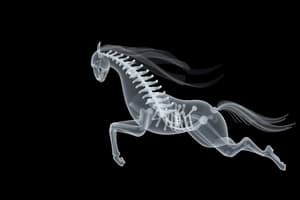Podcast
Questions and Answers
Which statement accurately describes how to find distance when given time and velocity?
Which statement accurately describes how to find distance when given time and velocity?
- Multiply distance by velocity
- Add velocity to distance
- Multiply time by velocity (correct)
- Divide velocity by time
What does the term 'displacement' refer to?
What does the term 'displacement' refer to?
- The distance an object moved without direction.
- The total path length traveled by an object.
- The speed of an object over period of time.
- The overall change in position of an object from start to finish with an included direction. (correct)
What term best describes the location of an object with respect to a starting point?
What term best describes the location of an object with respect to a starting point?
- Displacement (correct)
- Distance
- Speed
- Position
If a dog travels 210.0 meters east at a constant speed of 5.9 m/s, how long does the journey take?
If a dog travels 210.0 meters east at a constant speed of 5.9 m/s, how long does the journey take?
What is the correct term for velocity at the beginning of a time interval?
What is the correct term for velocity at the beginning of a time interval?
Which quantity represents a vector?
Which quantity represents a vector?
What physical quantity is represented by the slope of a position-time graph?
What physical quantity is represented by the slope of a position-time graph?
Which of the following is a vector quantity?
Which of the following is a vector quantity?
What do you obtain when you divide displacement by a given time interval?
What do you obtain when you divide displacement by a given time interval?
What does the slope of a displacement-time graph represent?
What does the slope of a displacement-time graph represent?
If the final position of an object is +19.8 m and its displacement was +7.3 m, where was the object's starting position?
If the final position of an object is +19.8 m and its displacement was +7.3 m, where was the object's starting position?
Which term describes velocity at one instant in time?
Which term describes velocity at one instant in time?
A ball is dropped from rest. What will its velocity be after 2.2 seconds, assuming the acceleration due to gravity is 9.8 m/s²?
A ball is dropped from rest. What will its velocity be after 2.2 seconds, assuming the acceleration due to gravity is 9.8 m/s²?
What can be determined from a position-time graph?
What can be determined from a position-time graph?
If a runner moves with a constant velocity of 8.77 m/s, how can you find the time taken to travel 47.9 m?
If a runner moves with a constant velocity of 8.77 m/s, how can you find the time taken to travel 47.9 m?
An object has a positive initial velocity and experiences a negative acceleration. How will the velocity of this object behave over time?
An object has a positive initial velocity and experiences a negative acceleration. How will the velocity of this object behave over time?
Flashcards
Displacement
Displacement
The change in position of an object from its initial to its final position.
Velocity
Velocity
The rate at which an object changes its position over time.
Acceleration
Acceleration
The rate at which an object changes its velocity over time.
Scalar
Scalar
Signup and view all the flashcards
Vector
Vector
Signup and view all the flashcards
Distance
Distance
Signup and view all the flashcards
Instantaneous Velocity
Instantaneous Velocity
Signup and view all the flashcards
Average Velocity
Average Velocity
Signup and view all the flashcards
Speed
Speed
Signup and view all the flashcards
Position-Time Graph
Position-Time Graph
Signup and view all the flashcards
Velocity-Time Graph
Velocity-Time Graph
Signup and view all the flashcards
Slope of Position-Time Graph
Slope of Position-Time Graph
Signup and view all the flashcards
Study Notes
Multiple Choice and True/False
-
Distance vs. Displacement: Distance is the total path traveled, while displacement measures the change in position from the starting point. (Question 1, a is correct).
-
Time to Cover Distance: If speed is known, time = distance/speed. To travel 210.0m east at 5.9 m/s it takes 210.0 m / 5.9 m/s = 35.6 seconds (Question 2, b is correct)
-
Position-Time Graph Slope: The slope of a position-time graph represents velocity (Question 3, c is correct).
-
Vector vs. Scalar: Velocity is a vector (having both magnitude and direction), while speed is a scalar (having only magnitude) (Question 4, c is correct).
-
Starting Position Calculation: If final distance and change in distance are known, the starting position can be calculated as follows: Starting Position = Final Distance – Change in Distance In this case, that would be 19.8 m - 7.3 m = +12.5 m. (Question 5, b is correct)
-
Velocity from Acceleration: Velocity = Final velocity = Initial Velocity + (Acceleration × Time). Velocity = 0 m/s + (9.8 m/s² × 2.2 s) = 21.56 which is approximately 22 m/s (Question 6, a is correct).
-
Position-Time Graph Information: A position-time graph allows determination of distance and displacement (Question 7, c is correct).
-
Velocity with Positive/Negative Acceleration: If initial velocity is positive and acceleration is negative, velocity decreases (Question 8, a is correct).
-
Acceleration Definition: Acceleration is the rate of change of velocity (Question 9, b is correct).
-
Speed vs. Velocity Difference: Speed is the magnitude of velocity, while velocity also specifies direction. Velocity changes when either speed or direction or both change.
-
Velocity-Time Graph Slope: A positive slope on a velocity-time graph indicates increasing velocity (positive acceleration), (Question 11, T).
-
Distance is Scalar: Distance is a scalar quantity, always a positive value (Question 12, T)
-
Circular Motion Average Velocity: If an athlete runs around a circular track and returns to the starting position, the average velocity is zero, because the net displacement is zero. (Question 13, T).
-
Comparing Speeds: 55 km/h is the faster speed compared to -55 km/h. Positive values or negative values for speed or velocity depend on direction relative to the positive direction of the chosen axis system. (Question 14, T).
-
Position-Time Graph Horizontal Line: A horizontal line on a position-time graph means the object is stationary (speed is zero), (Question 15, T).
-
Velocity-Time Graph Horizontal Line: Zero slope on a velocity-time graph means constant velocity, not acceleration (Question 16, T).
-
Distance/Displacement for Speed/Velocity: Distance is used to determine speed, and displacement is used to determine velocity. (Question 17, T)
-
Calculating Distance: Time multiplied by velocity will give you the distance covered. (Question 18, F)
-
Position Definition Position is the location of an object relative to a reference point. A is correct. (Question 19, C is correct).
-
Final Velocity: Final velocity (v2) is the velocity at the end of an interval. (Question 20, C is correct).
-
Initial Velocity: Initial velocity (v1) is the velocity at the beginning of an interval.(Question 21, A is correct).
-
Vector Definition: A vector is a quantity having both magnitude and direction. (Question 22, A is correct).
-
Average Velocity: Average velocity is displacement divided by time. (Question 23, A is correct).
-
Velocity-Time Graph Area: The area under a velocity-time graph represents the displacement. (Question 24, B is correct)
-
Instantaneous Velocity: Instantaneous velocity is the velocity at a particular moment in time. (Question 25, C is correct).
Part B: Diagrams (Position-Time Graph Analysis)
- Position at 5 seconds: (Answer needed from the diagram)
- Average velocity (first 11 seconds): (Answer needed from the diagram)
- Forward Motion Intervals: (Answer needed from the diagram)
- Backward Motion Intervals: (Answer needed from the diagram)
- Rest Intervals: (Answer needed from the diagram)
- Displacement (6s to 14s): (Answer needed from the diagram)
- Average Velocity (2s to 6s): (Answer needed from the diagram)
Part C: Problem Solving
- Average Velocity (Part C, Question 1): Average velocity = total displacement / total time. To calculate this you need the total displacement and total time for the trip. This requires the diagram information not provided above.
- Cheetah Distance (Part C, Question 2): Distance = speed × time Distance = (110 km/hr) × (5.0 s) = 550 km-s/hr (convert seconds to hours if needed as well) Additional information is required to solve for distance.
- Distance Traveled (Part C, Question 3): (Answer needed from the diagram)
- Displacement (Part C, Question 3): (Answer needed from the diagram)
- Speed (Part C, Question 3): Speed = total distance / total time = (Total distance from the diagram) / 100 seconds.
- Velocity (Part C, Question 3): Velocity = displacement / time = (net displacement from the diagram) / 100 seconds.
- Runner's Time (Part C, Question 5): Time = distance / speed = 47.9 m / 8.77 m/s = 5.46 seconds.
Studying That Suits You
Use AI to generate personalized quizzes and flashcards to suit your learning preferences.




